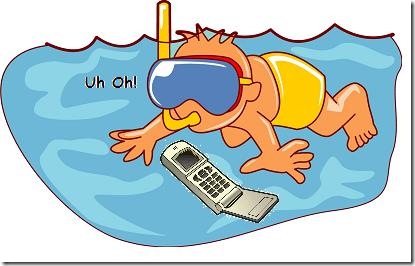
What do you do if your cell phone gets wet?
Let’s face it – it happens. We carry our cell phones everywhere we go, and we occasionally drop them, despite our best efforts. Now, depending on where we are when we drop them, the effect of the drop can vary. If you are in a carpeted room or on grass, chances are the phone is perfectly okay. If you were on concrete, there is a chance that you may have broken something or left a good scratch. However, what if you were on or around water, and the phone makes a splash landing? Well, you can consider following the steps below:*
1. Don’t panic. Take stock of the situation and proceed slowly, but DO NOT TURN ON THE DEVICE.
2. Remove the battery immediately if the device allows it. This is important, since it stops anything of an electrical nature from happening, and at the moment the phone is pretty much compromised along those lines.
3. What kind of water did the phone fall in? If it was anything besides more or less clear water consider rinsing the phone off gently, removing the residue. This is especially true if it was sea water, since the salt left behind will serve to cross out the circuits. However, use a rinse only if truly warranted, since you want to avoid introducing any more water into the phone’s chambers than absolutely needed.
4. Dry off the phone and battery the best you can, without using heat devices. A hairdryer is out of the question, since it can produce enough heat to ruin the electronics and the display, as well as warping the phone itself. Consider using an air source like a compressor to blow off the unit, and try to blow ACROSS it instead of into it, allowing water to be pulled from the device. Also great to use is a wet dry vacuum, which can suck the bulk water right out of the device. You want the water to leave the phone as quickly as possible, and hopefully through the same means and channels that it entered the phone.
5. Deep dry the phone using material that can absorb the water. If you have any desiccant, such as those packs of silica gel you see in electronics, then you are in good shape. If not, grab a container of dry uncooked rice, which will work well in a pinch. Place the phone and battery in the drying medium, covering it completely, and leave it there overnight. The important thing is to get the drying process started as soon as possible.
6. The next morning, and with your fingers crossed, extract the phone and battery from its desiccant home, wipe it off (rice may leave some powder on the phone), and insert the battery (if it was removed). With a little luck your phone will come back to life, and all will be good. If not, you are no worse off for the trying, but I do have to tell you that most electronics warranties do not cover water damage.
These are steps not just for cell phones, but for practically anything electronic. The rule of thumb is to pull the power without turning it on, remove any water or foreign material, and dry well. The faster you do this, the more likely no corrosion will take place and the electronics equipment will survive.
*disclaimer: Nerd Beach does not warrant the information contained here, and any action you take should be considered done on your own behalf. If unsure of the actions to take please seek professional assistance.
 A parabolic microphone works much like a satellite dish does, in that it uses a wide collector area that gathers the signal and focuses it on a smaller area, amplifying the signal as it does so. In this case, the signal is not radio frequency, but rather sound.
A parabolic microphone works much like a satellite dish does, in that it uses a wide collector area that gathers the signal and focuses it on a smaller area, amplifying the signal as it does so. In this case, the signal is not radio frequency, but rather sound.


